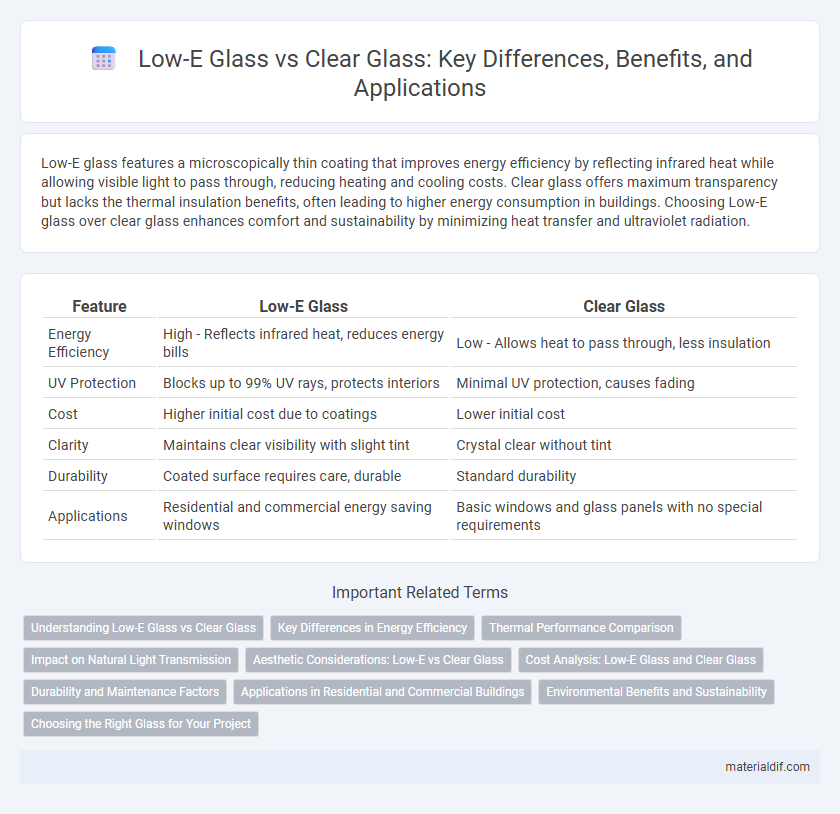Low-E glass features a microscopically thin coating that improves energy efficiency by reflecting infrared heat while allowing visible light to pass through, reducing heating and cooling costs. Clear glass offers maximum transparency but lacks the thermal insulation benefits, often leading to higher energy consumption in buildings. Choosing Low-E glass over clear glass enhances comfort and sustainability by minimizing heat transfer and ultraviolet radiation.
Table of Comparison
| Feature | Low-E Glass | Clear Glass |
|---|---|---|
| Energy Efficiency | High - Reflects infrared heat, reduces energy bills | Low - Allows heat to pass through, less insulation |
| UV Protection | Blocks up to 99% UV rays, protects interiors | Minimal UV protection, causes fading |
| Cost | Higher initial cost due to coatings | Lower initial cost |
| Clarity | Maintains clear visibility with slight tint | Crystal clear without tint |
| Durability | Coated surface requires care, durable | Standard durability |
| Applications | Residential and commercial energy saving windows | Basic windows and glass panels with no special requirements |
Understanding Low-E Glass vs Clear Glass
Low-E glass features a microscopically thin coating that reflects infrared energy, improving thermal insulation and reducing heat transfer compared to clear glass. Clear glass allows more visible light and heat to pass through, resulting in lower energy efficiency and higher cooling costs. Understanding the energy-saving benefits and UV protection of Low-E glass is crucial for selecting the right window option.
Key Differences in Energy Efficiency
Low-E glass features a microscopically thin coating that reflects infrared heat, significantly reducing energy loss compared to clear glass. This coating helps maintain indoor temperatures by allowing natural light to pass while blocking UV rays and insulating against heat transfer. Clear glass lacks these properties, resulting in higher energy consumption for heating and cooling in buildings.
Thermal Performance Comparison
Low-E glass features a microscopically thin metallic coating that significantly reduces heat transfer, resulting in superior thermal insulation compared to clear glass. While clear glass allows approximately 80-90% of solar heat to pass through, Low-E glass can reduce solar heat gain by up to 70%, enhancing energy efficiency in buildings. This thermal performance difference makes Low-E glass a preferred choice for minimizing heating and cooling costs in both residential and commercial applications.
Impact on Natural Light Transmission
Low-E glass significantly reduces the amount of infrared and ultraviolet light passing through windows while maintaining high visible light transmission, enhancing energy efficiency without compromising natural daylight. Clear glass allows maximum natural light transmission but offers minimal protection against heat gain and UV radiation, resulting in higher energy costs and potential interior fading. Using Low-E glass optimizes natural light intake while reducing glare and heat, creating a comfortable indoor environment with lower energy consumption.
Aesthetic Considerations: Low-E vs Clear Glass
Low-E glass typically exhibits a slight tint or reflective coating that alters the appearance of windows by reducing glare and enhancing privacy, while clear glass maintains full transparency and color fidelity, offering an unobstructed view. The subtle shading of Low-E glass can complement modern architectural designs by adding a sleek, sophisticated look, whereas clear glass suits applications where natural light and visual clarity are paramount. Low-E glass's aesthetic benefits include reduced fading of interior furnishings by filtering UV rays, making it a preferred choice for preserving interior decor without compromising exterior appearance.
Cost Analysis: Low-E Glass and Clear Glass
Low-E glass typically costs 10% to 15% more than clear glass due to its specialized coating that enhances energy efficiency by reflecting infrared light while allowing visible light to pass through. Although the initial investment is higher, Low-E glass significantly reduces heating and cooling expenses by minimizing heat transfer, often leading to long-term savings on energy bills. Clear glass, while cheaper upfront, lacks these energy-saving properties and can result in higher operational costs over time.
Durability and Maintenance Factors
Low-E glass features a durable metallic coating that enhances resistance to scratches and environmental wear, significantly extending its lifespan compared to clear glass. Unlike clear glass, Low-E glass requires minimal maintenance due to its ability to reduce dirt accumulation and prevent moisture-related damage. The energy efficiency of Low-E glass also contributes to lower upkeep costs by maintaining consistent indoor temperatures and reducing HVAC strain.
Applications in Residential and Commercial Buildings
Low-E glass enhances energy efficiency in residential and commercial buildings by reducing heat transfer and UV radiation, making it ideal for windows, skylights, and facades. Clear glass is commonly used where maximum natural light and clarity are desired, but it lacks the insulating properties of Low-E glass. Selecting Low-E glass in building applications helps lower heating and cooling costs while maintaining occupant comfort and protecting interior furnishings.
Environmental Benefits and Sustainability
Low-E glass significantly reduces energy consumption by minimizing heat transfer, which lowers greenhouse gas emissions and enhances building energy efficiency compared to clear glass. Its reflective coating improves insulation, reducing the need for artificial heating and cooling, thereby conserving natural resources. Choosing Low-E glass supports sustainable building practices by decreasing carbon footprints and promoting long-term environmental benefits.
Choosing the Right Glass for Your Project
Low-E glass offers superior energy efficiency by minimizing heat transfer and blocking harmful UV rays, making it ideal for projects prioritizing insulation and climate control. Clear glass provides maximum transparency and natural light, suitable for applications where visibility and aesthetics are the primary concerns. Evaluating factors such as thermal performance, sunlight exposure, and budget will guide the choice between Low-E and clear glass to meet specific project requirements.
Low-E glass vs Clear glass Infographic

 materialdif.com
materialdif.com